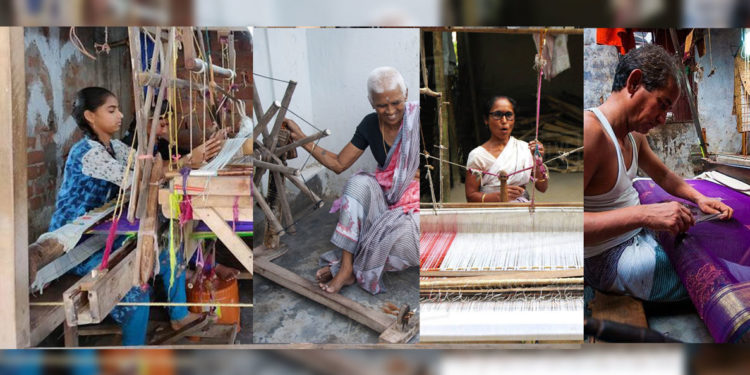In today’s era of mechanisation and technology, everything is fast-paced. However, amongst all the technological advancements, the gradual process of handloom weaving is highly commendable. The art of weaving is time-consuming and requires a lot of effort. It is said that a weaver has about an average of seven years of experience in the skill. This National Handloom Day, it is important to learn about the weaving culture in AP.
Initially starting as a Swadeshi project to promote domestic garments, National Handloom Day was celebrated to encourage weavers, and handloom artisans, to self-sustain themselves. However, the movement picked up momentum gradually and is still celebrated today. The craftsmanship in making a loom is extremely mesmerizing and a person has to witness this atleast once in their lifetime. On this National Handloom Day, we have curated a list of places you can visit to get a hands-on experience of seeing how weaving is done.
#1 Uppada Coast, East Godavari
The womenfolk, from the fishing community of the Uppada Coast, hand weave Uppada silk sarees and are well known for their jamdani technique; which originated in Bengal. The jamdani technique uses immense craftsmanship to weave motifs that appear the same on the front and backside of a sari. Most of the handloom workers in the Uppada village are women and young girls. The craft is passed on from generation to generation and everyone in a family is expected to contribute to the business. Every household in the Uppada Village has a loom and also a store to sell the famous Uppada pattu sarees. Celebrities come to the village to place special orders and a sari can cost anywhere between Rs.3,000 to Rs. 1 lakh depending on the finish and designs.
Uppada village is 134.5 km from Vizag and the fastest way to reach there is via train.
#2 Ponduru, Srikakulam
Ponduru Village is world-famous for the handspun Khadi produced solely there and is the only Khadi village in India. The khadi, produced in this village, has its own Geographical Handloom Identification tag. It is handspun and woven by the weavers of the village and is a sight to behold. The Ponduru Khadi was said to be Mahatma Gandhi’s favourite garment during the freedom struggle movement and the swadeshi movement. This is probably one of the only few places where the single spindle chakra is still spinning.
The distance between Vizag and Ponduru village is 88 km and the easiest way to reach there is via bus.
#3 Bobbili, Narayanapuram
The handloom sarees, woven in this village, are the famous Bobbili sarees and were once sold for 10 rupees each. These sarees however are not inexpensive anymore and are economically priced. The village boasts of soft cotton sarees in a wide range of colours. It is interesting to note that Narayanapuram has approximately 50 maggams (looms), which are used in rotation. The production cost and threads are provided by Bobbili saahukras and on average, eight sarees are prepared per week in this village. The produce directly goes to the businessmen of Bobbili and is later sold off to customers.
The distance between Vizag and Bobbili village is approximately 120 Km and the travel time is two and a half hours.
#4 Mangalagiri, Guntur
Also famous for its temples, Mangalagiri is renowned for its colourful and soft silks and cotton. Mangalagiri is a destination that attracts tourists from various parts of the country for its handloom. A traditional Mangalagiri is spun with rich gold borders. However, modern weaves vary widely in colour range. The yarn to make a Mangalagiri silk undergoes a month-long process of being dyed and dried to be prepared for the loom. This silk takes a day to be created on the loom and is of exquisite quality.
The distance from Vizag to Mangalagiri is 360 Kms and the easiest way to travel is via train.










Discussion about this post